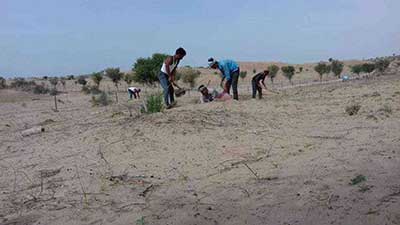Date: 20/02/2023
Relevance: GS-3: Climate Change and its impacts.
Key Phrases: Climate Change, Thar Desert, Indian Ocean Warm Pool, Rainfall and Climate Data, COP (Conference of Parties), UNCCD, Global Warming, Indian Ocean Region, Arabian Sea, Somalia Coast, Upwelling, Spin of the Earth.
Context:
- Recently, two researchers, PV Rajesh of the Indian Institute of Tropical
Meteorology, Pune, and BN Goswami of the Department of Physics, Cotton
University, Guwahati, have postulated that the demise of the Thar desert
is a distinct possibility due to global warming.
- They based their theory on rainfall and climate data, with a focus on what is known as the Indian Ocean Warm Pool (IOWP).
Key Highlights:
- Climate change has many deleterious consequences but on the other side it may be beneficial for the Thar desert.
Towards the greening of the Thar Desert:
- The existence of the Indian Ocean Warm Pool (IOWP) in the Indian Ocean has been known for decades.
- Indian Ocean warm pool (IOWP), defined as areas with sea surface
temperature (SST) values > 28 °C is significantly expanding in most regions.
- With global warming, the IOWP is expanding westwards.
- Atmospheric winds cool the ocean surface through evaporation, sometimes
forcing colder, deep waters to come up. This phenomenon is known as
‘Upwelling’.
- This happens near the Somalia coast in the western Arabian Sea during summer.
- Therefore, the waters in the region are cooler, leaving a ‘warm pool’ elsewhere.
- At the warm pool’s western boundary, evaporating waters rise but the spin of the earth yanks them diagonally across India.
- So, the northeastern region gets rainfall for 150 days, while the north-western region gets only 70 days.
- With the IOWP expanding westward, the ‘length of the rainy season’ would
result in a 50-100 per cent increase in the mean summer rainfall over the
semi-arid northwest of India.
- Therefore, the Thar desert could receive good rains and slowly become green.
Thar Desert
- The Great Indian Desert, well known as the Thar Desert, is a large and arid region in the northwestern part of the Indian subcontinent.
- It covers about 200,000 square kilometres.
- It forms a natural boundary between India and Pakistan.
- India has about 85% of the Thar Desert while the rest is in
Pakistan.
- It is located partly in Rajasthan, Gujarat state, northwestern India, and partly in Punjab and Sindh (Sind) provinces, eastern Pakistan.
- It is an undulating sandy plain covered with sand dunes.
- This region receives very low rainfall below 150 mm per year. It has an arid climate with low vegetation cover.
- Along with the gradual destruction of the Aravalli ranges, it is expanding fast because of the migration of people, changes in the rainfall pattern, spread of sand dunes and unscientific plantation drive.
United Nations Convention to Combat Desertification
- The United Nations Convention to Combat Desertification (UNCCD) is a Convention to combat desertification and mitigate the effects of drought through national action programs that incorporate long-term strategies supported by international cooperation and partnership arrangements.
- The Convention, the only convention stemming from a direct recommendation of the Rio Conference's Agenda 21, was adopted in Paris, France, on 17 June 1994 and entered into force in December 1996.
- It is the only internationally legally binding framework set up to address the problem of desertification.
- It is based on the principles of participation, partnership and decentralization—the backbone of good governance and sustainable development.
- COP14 was held in New Delhi in 2019.
Expected Timeline:
- It is not possible to say whether it will happen in 50 years or in 100 years, but as global warming is likely to continue at least till the end of the century, the westward expansion of the Indian monsoon will continue.
- The length of the monsoon season is expected to increase from about 70 days to about 90 days and annual rainfall to increase from about 45 cm to about 70 cm by that time.
- The increased rainfall spread over a longer season will help grow
taller vegetation.
- During the dry winter season, the plants may die unless the water is made available through irrigation or uplift of the water table.
- So, greening could be accelerated if the run-off during the monsoon season could be harvested.
Conclusion:
- In the long term, the increased rainfall has the potential to green
the desert and significantly increase food production in the region.
- But in the short term, it is necessary to plan for harvesting the excess water to increase groundwater reserves.
Source: The Hindu BL
Mains Question:
Q.Describe the Indian Ocean Warm Pool. Examine the impacts of the IOWP on India’s monsoon distribution. (150 Words).






















